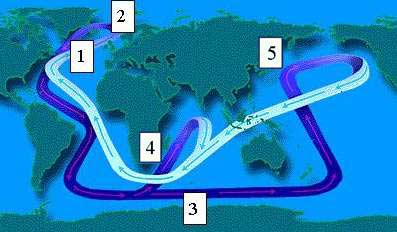
> ENC Master > Climate Encyclopaedia > Oceans > basics > 1. Oceans and climate > * Worksheet 2
|
|
 |
The Oceans
Basics |
Worksheet: Oceans and Climate
Sheet 2: Ocean Circulation |
Answer the following questions on ocean circulation.
1. What controls ocean circulation?
|
a) Volcanism and the continental drift of Earth plates
|
 |
|
b) the coriolis force and storms.
|
 |
|
c) heat and salt coming from desert storms
.
|
 |
|
d) Variations in the density of the water in different parts of the ocean and wind driven currents.
|
 |
|
|
2. What does "thermo" stand for?
|
a) Hot drink.
|
 |
|
b) Cold.
|
 |
|
c) Warm weather.
|
 |
|
d) Temperature.
|
 |
|
|
3) What does “haline” mean?
|
a) Salty.
|
 |
|
b) Halo shaped.
|
 |
|
c) Hail.
|
 |
|
d) Sweet.
|
 |
|
|
4. What does “thermohaline circulation” mean?
|
a) Movement of water due to its high temperature and its salt content.
|
 |
|
b) Movement of water due to its temperature and its low salt content.
|
 |
|
c) Movement of water due to its temperature and its salt content.
|
 |
|
d) Movement of water due to its low temperature and its high salt content.
|
 |
|
Exercise:
Have a look at the graphic and then answer the following questions.
(use your atlas)
|
 |
 |
|
Streams, image by Lucinda Spokes
|
|
Explanation of the picture:
1. Gulf Stream
2. North Atlantic Deep Water
3. Antarctic Bottom Water
4. Agulhas Current
5. Kuroshio Current
Now the questions.
Click the blue button for cold and the red one for warm.
|
1. Is Antarctic Bottom Water cold or warm?
|
 |
|
2. Is Gulf Stream water cold or warm?
|
 |
|
3. Is North Atlantic Deep Water cold or warm?
|
 |
|
4. Is the Agulhas Current cold or warm?
|
 |
|
|
Exercise:
Where can you find these currents?
Click "P" for Pacific, "A" for Atlantic and "I" for Indian Ocean.
|
In which ocean is Gulf Stream water?
|
 |
|
In which ocean is the Kuroshio Current?
|
 |
|
In which ocean is the Agulhas Current?
|
 |
|
|
|
|
Answer the following questions. |
|
|
1) How long does it take for water to travel around the world? |
|
|
|
2) What best describes the situation at number 1 on the map? |
|
|
|
3) What best describes the situation at number 2 on the map? |
|
|
|
4) Where does new deep water formation occur in the Northern Hemisphere? |
|
|
|
5) What best describes the situation at number 3 on the map? |
|
|
|
6) What happens around Antarctica? |
|
|
|
7) What causes deep water to move up to the surface of the ocean? |
|
|
| |
|
|
|
Attention: This quiz is optimised for Internet Explorer or new versions of Netscape!
If the little answer window disappears, just reopen it using the 'Show Solution' button! |
|
|
|
|
|
|
| |
About this page:
- Author: - Prof. Dr. Schrettenbrunner - University of Nürnberg - Germany
- scientific reviewing: Lucinda Spokes
- educational reviewing: Dr. Schleicher / J. Heres
- last update: 16.12.03
|
 > ENC Master > Climate Encyclopaedia > Oceans > basics > 1. Oceans and climate > * Worksheet 2
> ENC Master > Climate Encyclopaedia > Oceans > basics > 1. Oceans and climate > * Worksheet 2

